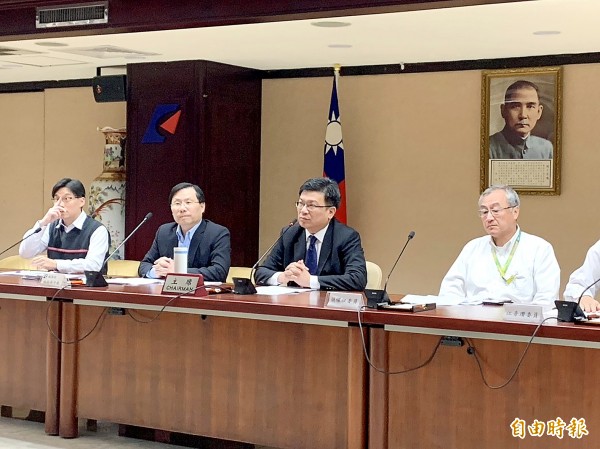《TAIPEI TIMES》 Final feed-in tariff set for wind firms

Deputy Minister of Economic Affairs Tseng Wen-sheng, second right, announces the government’s feed-in tariff for renewable energy at a news conference in Taipei yesterday Photo: Lin Ching-hua, Taipei Times
MILDER CUTS: Taiwan remains committed to offshore wind energy, Deputy Minister of Economic Affairs Tseng Wen-sheng said, urging developers not to give up easily
By Ted Chen / Staff reporter
The Ministry of Economic Affairs yesterday announced the government’s finalized feed-in tariff (FIT) for renewable energy, with the outcome showing milder pricing cuts than previously proposed.
The cap on the FIT for offshore wind energy over the next 20 years is set at NT$5.516 per kilowatt-hour (kWh), representing a 5.71 percent cut from last year’s NT$5.8498, as opposed to the much steeper 12.71 percent cut to NT$5.106 first proposed in November last year.
The new FIT pricing takes into account concerns voiced by offshore wind developers, who have said that a steep reduction would threaten the viability of projects, while pundits have questioned the perceived generosity of the government’s renewable energy purchasing price, Bureau of Energy Director-General Lin Chuan-neng (林全能) said at a news conference in Taipei.
Following negotiations with developers, the renewable energy review committee acknowledged that offshore wind projects are more costly to build in Taiwan and must be supported with higher rates, Lin said.
Taiwan’s rougher seas permit fewer construction days, while the nation’s coastal ocean floors require more costly underwater jacket structures, he said.
Offshore wind developers in Taiwan have absorbed additional expenses not found in projects in other markets, such as conducting the initial survey and project evaluation and upgrading power grids, as well as offering incentives to affected fishers, Lin said.
While the government has agreed not to cancel a tiered FIT scheme in which energy purchases are higher over the first 10 years before tapering off in the next decade, the rate has been changed from 7-3 to 6-4.
The revised rate would ensure that offshore wind developers are committed to project operations for a minimum of 10 years and address the requirements of project financiers, Lin said.
The updated terms also raised the cap on offshore energy procurement from 3,600kWh to 3,750kWh to encourage the adoption of newer and bigger 8 megawatt (MW) turbines, instead of 4MW variants.
The government turned down developers’ request to forgo an annual cap on offshore wind energy procurement, Lin said, adding that the FIT rate would fall by 25 percent to NT$4.137 when output exceeds 4,200kWh and a further 50 percent to NT$2.758 beyond 4,500kWh.
“We will not extend a bigger reward to developers simply because the winds were more favorable in a certain year,” Lin said.
The latest FIT scheme does not include the additional cost burden of local content requirements, as local supply chain partners would get up to speed and become cost efficient with time, he added.
Lin said he is optimistic that the central government and the Changhua County Government can resolve an impasse that has prevented some developers from receiving project permits.
“We should be getting a definitive answer in the next two days,” Lin said, adding that the county government stated in an official letter to the bureau that it does not have the authority to approve projects.
The government stands behind its new FIT pricing, Deputy Minister of Economic Affairs Tseng Wen-sheng (曾文生) said, adding that the public can check how the rate was derived.
“The government remains committed to offshore wind energy and we urge developers to not give up on projects easily,” Tseng said.
The FIT rate for solar power and other renewable energy sources also saw lower reductions. Solar energy has a new biannual rate with a maximum reduction of 6.15 percent for the first half of the year and a maximum of 7.78 percent for the second half, compared with a 12.15 percent cut proposed before.
新聞來源:TAIPEI TIMES
%http://www.taipeitimes.com/














